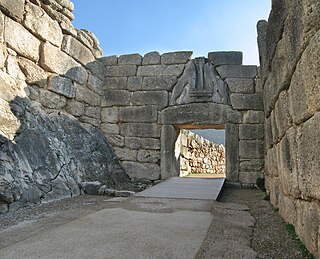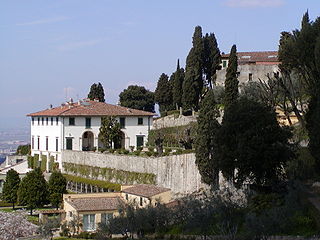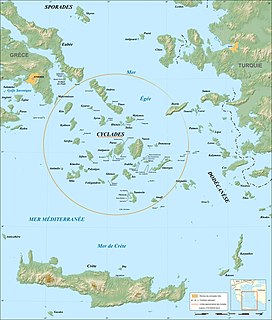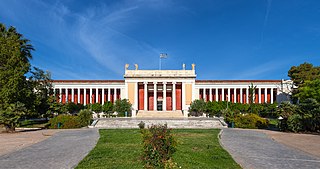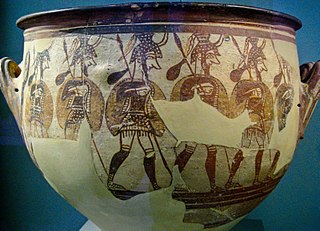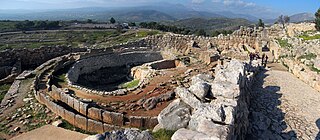Discovery
The curtain-wall and towers of the Mycenaean citadel, its gate with heraldic lions, and the great "Treasury of Atreus" had borne silent witness for ages before Heinrich Schliemann's time; but they were supposed only to speak to the Homeric, or, at farthest, a rude Heroic beginning of purely Hellenic civilization. It was not until Schliemann exposed the contents of the graves which lay just inside the gate, that scholars recognized the advanced stage of art which prehistoric dwellers in the Mycenaean citadel had attained.
There had been, however, a good deal of other evidence available before 1876, which, had it been collated and seriously studied, might have discounted the sensation that the discovery of the citadel graves eventually made. Although it was recognized that certain tributaries, represented for example, in the XVIIIth Dynasty tomb of Rekhmara at Egyptian Thebes as bearing vases of peculiar forms, were of some Mediterranean race, neither their precise habitat nor the degree of their civilization could be determined while so few actual prehistoric remains were known in the Mediterranean lands. Nor did the Aegean objects which were lying obscurely in museums in 1870, or thereabouts, provide a sufficient test of the real basis underlying the Hellenic myths of the Argolid, the Troad and Crete, to cause these to be taken seriously. Aegean vases have been exhibited both at Sèvres and Neuchatel since about 1840, the provenance (i.e. source or origin) being in the one case Phylakope in Melos, in the other Cephalonia.
Ludwig Ross, the German archaeologist appointed Curator of the Antiquities of Athens at the time of the establishment of the Kingdom of Greece, by his explorations in the Greek islands from 1835 onwards, called attention to certain early intaglios, since known as Inselsteine; but it was not until 1878 that C. T. Newton demonstrated these to be no strayed Phoenician products. In 1866 primitive structures were discovered on the island of Therasia by quarrymen extracting pozzolana, a siliceous volcanic ash, for the Suez Canal works. When this discovery was followed up in 1870, on the neighbouring Santorini (Thera), by representatives of the French School at Athens, much pottery of a class now known immediately to precede the typical late Aegean ware, and many stone and metal objects, were found. These were dated by the geologist Ferdinand A. Fouqué, somewhat arbitrarily, to 2000 BC, by consideration of the superincumbent eruptive stratum.
Meanwhile, in 1868, tombs at Ialysus in Rhodes had yielded to Alfred Biliotti many fine painted vases of styles which were called later the third and fourth "Mycenaean"; but these, bought by John Ruskin, and presented to the British Museum, excited less attention than they deserved, being supposed to be of some local Asiatic fabric of uncertain date. Nor was a connection immediately detected between them and the objects found four years later in a tomb at Menidi in Attica and a rock-cut "bee-hive" grave near the Argive Heraeum.
Even Schliemann's first excavations at Hissarlik in the Troad did not excite surprise. But the "Burnt City" of his second stratum, revealed in 1873, with its fortifications and vases, and a hoard of gold, silver and bronze objects, which the discoverer connected with it, began to arouse a curiosity which was destined presently to spread far outside the narrow circle of scholars. As soon as Schliemann came on the Mycenae graves three years later, light poured from all sides on the prehistoric period of Greece. It was recognized that the character of both the fabric and the decoration of the Mycenaean objects was not that of any well-known art. A wide range in space was proved by the identification of the Inselsteine and the Ialysus vases with the new style, and a wide range in time by collation of the earlier Theraean and Hissarlik discoveries. A relationship between objects of art described by Homer and the Mycenaean treasure was generally allowed, and a correct opinion prevailed that, while certainly posterior, the civilization of the Iliad was reminiscent of the Mycenaean.
Schliemann got to work again at Hissarlik in 1878, and greatly increased our knowledge of the lower strata, but did not recognize the Aegean remains in his "Lydian" city of the sixth stratum. These were not to be fully revealed until Dr. Wilhelm Dorpfeld, who had become Schliemann's assistant in 1879, resumed the work at Hissarlik in 1892 after the first explorer's death. But by laying bare in 1884 the upper stratum of remains on the rock of Tiryns, Schliemann made a contribution to our knowledge of prehistoric domestic life which was amplified two years later by Christos Tsountas's discovery of the palace at Mycenae. Schliemann's work at Tiryns was not resumed till 1905, when it was proved, as had long been suspected, that an earlier palace underlies the one he had exposed.
From 1886 dates the finding of Mycenaean sepulchres outside the Argolid, from which, and from the continuation of Tsountas's exploration of the buildings and lesser graves at Mycenae, a large treasure, independent of Schliemann's princely gift, has been gathered into the National Museum at Athens. In that year tholos-tombs, most already pillaged but retaining some of their furniture, were excavated at Arkina and Eleusis in Attica, at Dimini near Volos in Thessaly, at Kampos on the west of Mount Taygetus, and at Maskarata in Cephalonia. The richest grave of all was explored at Vaphio in Laconia in 1889, and yielded, besides many gems and miscellaneous goldsmiths' work, two golden goblets chased with scenes of bull-hunting, and certain broken vases painted in a large bold style which remained an enigma until the excavation of Knossos.
In 1890 and 1893, Staes cleared out certain less rich tholos-tombs at Thoricus in Attica; and other graves, either rock-cut "bee-hives" or chambers, were found at Spata and Aphidna in Attica, in Aegina and Salamis, at the Argive Heraeum and Nauplia in the Argolid, near Thebes and Delphi, and not far from the Thessalian Larissa. During the Acropolis excavations in Athens, which terminated in 1888, many potsherds of the Mycenaean style were found; but Olympia had yielded either none, or such as had not been recognized before being thrown away, and the temple site at Delphi produced nothing distinctively Aegean (in dating). The American explorations of the Argive Heraeum, concluded in 1895, also failed to prove that site to have been important in the prehistoric time, though, as was to be expected from its neighbourhood to Mycenae itself, there were traces of occupation in the later Aegean periods.
Prehistoric research had now begun to extend beyond the Greek mainland. Certain central Aegean islands, Antiparos, Ios, Amorgos, Syros and Siphnos, were all found to be singularly rich in evidence of the Middle-Aegean period. The series of Syran-built graves, containing crouching corpses, is the best and most representative that is known in the Aegean. Melos, long marked as a source of early objects but not systematically excavated until taken in hand by the British School at Athens in 1896, yielded at Phylakope remains of all the Aegean periods, except the Neolithic.
A map of Cyprus in the later Bronze Age (such as is given by J. L. Myres and M. O. Richter in Catalogue of the Cyprus Museum) shows more than 25 settlements in and about the Mesaorea district alone, of which one, that at Enkomi, near the site of Salamis, has yielded the richest Aegean treasure in precious metal found outside Mycenae. E. Chantre in 1894 picked up lustreless ware, like that of Hissariik, in central Phtygia and at Pteria, and the English archaeological expeditions, sent subsequently into north-western Anatolia, have never failed to bring back ceramic specimens of Aegean appearance from the valleys of the Rhyndncus, Sangarius and Halys.
In Egypt in 1887, Flinders Petrie found painted sherds of Cretan style at Kahun in the Fayum, and farther up the Nile, at Tell el-Amarna, chanced on bits of no fewer than 800 Aegean vases in 1889. There have now been recognized in the collections at Cairo, Florence, London, Paris and Bologna several Egyptian imitations of the Aegean style which can be set off against the many debts which the centres of Aegean culture owed to Egypt. Two Aegean vases were found at Sidon in 1885, and many fragments of Aegean and especially Cypriot pottery have been found during recent excavations of sites in Philistia by the Palestine Fund.
Sicily, ever since P. Orsi excavated the Sicel cemetery near Lentini in 1877, has proved a mine of early remains, among which appear in regular succession Aegean fabrics and motives of decoration from the period of the second stratum at Hissarlik. Sardinia has Aegean sites, for example, at Abini near Teti; and Spain has yielded objects recognized as Aegean from tombs near Cadiz and from Saragossa.
One land, however, has eclipsed all others in the Aegean by the wealth of its remains of all the prehistoric ages— Crete; and so much so that, for the present, we must regard it as the fountainhead of Aegean civilization, and probably for long its political and social centre. The island first attracted the notice of archaeologists by the remarkable archaic Greek bronzes found in a cave on Mount Ida in 1885, as well as by epigraphic monuments such as the famous law of Gortyna (also called Gortyn). But the first undoubted Aegean remains reported from it were a few objects extracted from Cnossus by Minos Kalokhairinos of Candia in 1878. These were followed by certain discoveries made in the S. plain Messara by F. Halbherr. Unsuccessful attempts at Cnossus were made by both W. J. Stillman and H. Schliemann, and A. J. Evans, coming on the scene in 1893, travelled in succeeding years about the island picking up trifles of unconsidered evidence, which gradually convinced him that greater things would eventually be found. He obtained enough to enable him to forecast the discovery of written characters, till then not suspected in Aegean civilization. The revolution of 1897–1898 opened the door to wider knowledge, and much exploration has ensued, for which see Crete.
Thus the "Aegean Area" has now come to mean the Archipelago with Crete and Cyprus, the Hellenic peninsula with the Ionian islands, and Western Anatolia. Evidence is still wanting for the Macedonian and Thracian coasts. Offshoots are found in the western Mediterranean area, in Sicily, Italy, Sardinia and Spain, and in the eastern Mediterranean area in Syria and Egypt. Regarding the Cyrenaica, we are still insufficiently informed.








